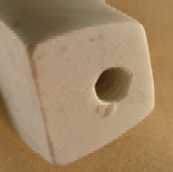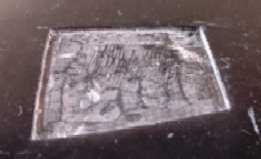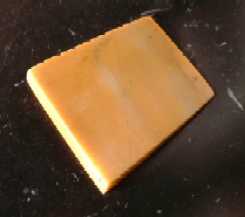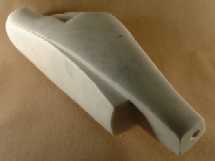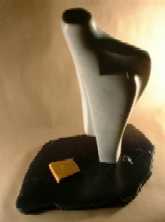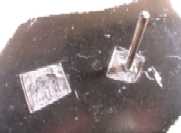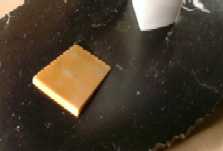 | ||||
home / about the artist / stoneboat series / lipwork series / metaphorical presences / landscapes / multi-element installation pieces / recent works
technical processes / thumbnail galleries / Cortona foundry / Finland stone carving / recommended reading / all in the family / links page
The 'footprint' is then carefully scribed and the interior cut away, testing and fitting the yellow piece a number of times to the hole during the process.
To create the illusion that it penetrates to depth within the black marble base, the yellow piece must fit snugly into the recess.
 | ||||
 | ||||
TO INLAY A PIECE INTO THE SURFACE
THE PROCESS: FITTING AND INLAYING
A hole is bored up several inches into the bottom of the white marble element.
TO FIT AND MOUNT TO A BASE
A matching metal rod is fitted through a similar hole in the black base.
Because the black marble is only a thin slab, the underside is reinforced with a metal plate to which the rod is welded. The whole metal assembly is then fitted and cemented to the marble with epoxy.
Bottom of the base with the metal plate shown cemented to the
underside.
The white form is fitted down on the rod and aligned as needed. The outline of the 'footprint' is scribed onto the black marble. The white element is removed and the surface of the 'footprint' in the black marble is carved away to the necessary depth (in this case about1/8").
 | ||||
The tapered trapezoidal yellow piece is placed on the black base so as to create a certain balanced relationship with the placement of the white element.
Top view of the base after the two 'footprints' were carved to depth, with and without the fitted white and
yellow elements in place.
The small work-in-progress at right is an example of the process of mounting a vertical form (white italian marble) onto a horizontal base (black spanish marble), and the addition of a third contrasting and complementary element (yellow italian marble).
 | ||||
 | ||||
 | ||||
 | ||||
 | ||||
 | ||||
 | ||||
www.dondougan.com
DON DOUGAN
a design for a shop-built carving stand:
a facebook album illustrating methods of mounting wall pieces:
To combine several pieces of material in a single sculpture they need to be fitted together and joined in some manner.
This process may be used for a result as basic as the fabrication of a support to hold the primary form onto its base, or it can be used to create complex illusions of interpenetration of form and material.
